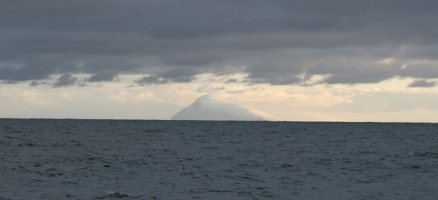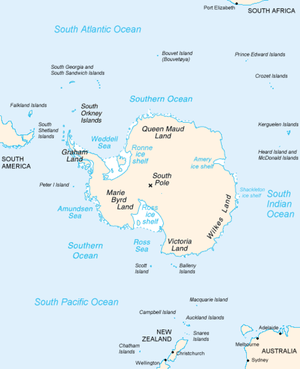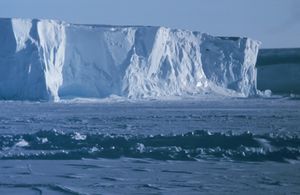Ross Sea
Further to the east of the Ross Sea lies the Amundsen Sea.
The Ross Sea is the closest of all the world's seas to the South Pole, with that portion of the Ross Sea closest to the South Pole being marine water under the Ross Ice Shelf.
Contents
Ross Ice Shelf
See main article: Ross Ice Shelf
The Ross Ice Shelf is the largest ice shelf in the world with an area of roughly 182,000 square miles (472,000km²), and is about the size of Spain. This ice topographic landform is one of the 47 named Antarctic Ice Shelves. It is bordered by the Ross Sea, the Transantarctic Mountains to the west and south, and by the King Edward the VII Peninsula to the east.
Facing and overlying much of the coastal zone of the Ross Sea, it presents a nearly vertical icecliff of between 50 and 200 feet (15 and 60 meters) above the water surface and500 miles(800 km) long between Ross Island and the King Edward the VII Peninsula. The interior of the Shelfentends from 400 to nearly 600 miles.
Most of the Ross Ice Shelf is located within the Ross Dependency claimed by New Zealand. However, the claim is not recognized by most countries or under the Antarctic Treaty System.
The ice shelf was named after Captain James Clark Ross who discovered it on 28 January 1841. It was originally named the Great Ice Barrier orthe Ice Barrier or simply the Barrier. Ross mapped the ice front eastward to 160°W.
Circulation and Marine Chemistry
Physical forcing, including advective circulation, vertical mixing, and vertical stratification, may be the primary factor producing observed vertical and horizontal variability in phytoplankton distribution as well as primary production in the Ross Sea. Furthermore, the exchange of Circumpolar Deep Water (CDW) onto Antarctic Seas and continental shelves influences sea ice and biological processes. Circumpolar Deep Water intrudes onto the shelf in the eastern Ross Sea due to wind and topographic effects.
There is westward, wind driven flow along the Ross Ice Shelf and a northward boundary flow occurs along the western Ross Sea. Circulation and nutrient transport are affected by bottom topography. A strong northwestward current, with an associated V-front, flows along the shelf break. Onshore flow occurs at the shelf break over more shallow banks, although offshore flow is seen in the troughs. The advection and diffusion of nutrients as passive tracers leads to them being retained in the surface layer near Ross Island.
Marine Ecosystem
One of the largest ice shelf areas around the Antarctic continent is found in the southern part of the Ross Sea. The Antarctic Circumpolar Current flows around Antarctica and provides a partial return of water to the South Pacific, the South Indian Ocean and the South Atlantic Ocean. The Antarctic LME is considered a Class III, low productivity (<150 grams of carbon per metre squared per year) ecosystem. The low productivity is linked with extreme weather conditions, and also with the limitedlight penetration due to the winter ice cover. In the Ross Sea, the seasonal production cycle is determined by ice formation in the fall and ice melting in the spring and Summer.
Marine species in all the Antarctic seas have unique ecological and biological characteristics. The base of the marine food chain is supported by about 100 species of phytoplankton. Some 200 Antarctic finfish species are found south of the Antarctic Convergence, 25 percent of which are unique to the area. The species of zooplankton, fish, squid, benthic organisms, seals, whales, and birds found at this latitude have sophisticated mechanisms for survival under very cold conditions. Low metabolic rates help them maintain a higher rate of protein synthesis. The food chain is abbreviated and based almost entirely on krill (Euphausia superba), a small shrimp-like crustacean and a key species crucial to the sustainability and production of all other fisheries. Baleen whales, seals, penguins, squid, fish and seabirds all feed on krill. The entire region is an international science laboratory where scientists study weather and climate, oceanography, geology and glaciology.
Terrestrial Margin Ecosystem
See main article: Maudlandia Antarctic desert
The Maudlandia Antarctic desert differs from Marielandia in that the larger expanses of ice-free land are found inland and in parts of Antarctica such as the coast of the Ross Sea, rather than near the Antarctic Peninsula coast. It is within some of the valleys of Maudlandia that the most outstanding examples of life adapted to the extreme climate occur. In this landscape that was once assumed to be completely barren, microbiologists in the 1970s discovered communities of microscopic algae, fungi, and bacteria living protected inside rocks. These organisms live in minute gaps between grains of sandstone, close to the surface of the semi-translucent rock where they can receive some sunlight and moisture, and also receive nourishment from the minerals in the stone. These organisms are known as cryptoendolithic microorganisms. Other such algal species as Hemichloris antarctica, are specially adapted to repeated freezing and re-thawing. Recently discovered by divers, the bottom of some lakes support a microbial mat made up of many species of blue-green algae, similar to those thought to be the earliest life-forms and the original sources of oxygen on the planet. The unlikely top predator within some of these icy valleys is a bacteria-eating nematode that can survive multiple years of being freeze-dried—entering a state called anhydrobiosis. Certain lichen species, for example, Buellia frigida, might grow as little as one centimeter in 1000 years.
References
- John W. and B.Lyle Hansen. 1979. Ross Ice Shelf Project Clough. Science, Vol. 203, No. 4379, Feb. 2, 1979, pp. 433-455;RISP Technical Reports are available from from the ROSS Ice Shelf Project Management Office, University of Nebraska, Lincoln, NE
- M.D.F.Udvardy. 1975. A classification of the biogeographical provinces of the world. IUCN Occasional Paper No. 18. International Union of Conservation of Nature and Natural Resources, Morges, Switzerland.
- M.D.F.Udvardy. 1987. The Biogeographical Realm Antarctica A Proposal. Journal of the Royal Society of New Zealand 17:187-194.
- G.E.Watson, , J.P.Angle, and P.C.Harper. 1975. Birds of the Antarctic and Sub-Antarctic. American Geophysical Union, Washington, D.C. ISBN: 0875901247
- Rhodes W. Fairbridge, editor. 1966. The Encyclopedia of Oceanography. Van Nostrand Reinhold Co.


